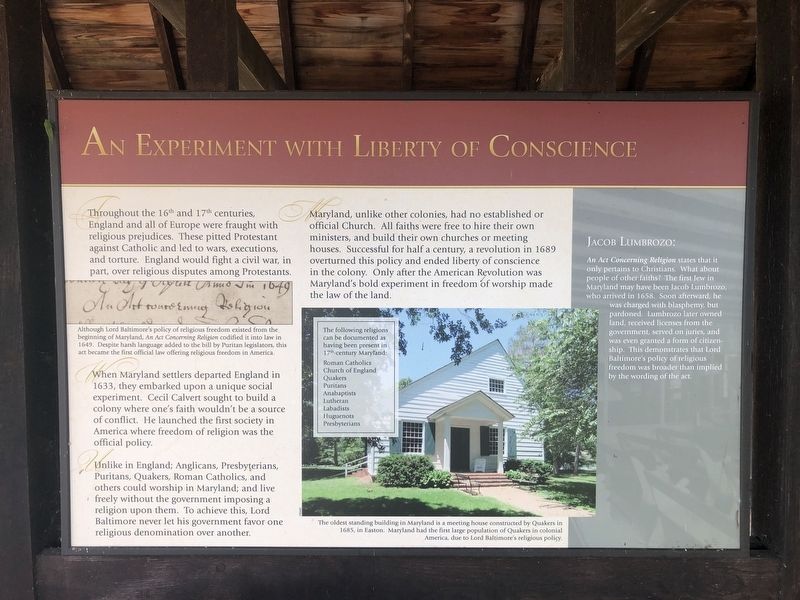St. Mary's City in St. Mary's County, Maryland — The American Northeast (Mid-Atlantic)
An Experiment with Liberty of Conscience

Photographed By Devry Becker Jones (CC0), August 30, 2019
1. An Experiment with Liberty of Conscience Marker
When Maryland settlers departed England in 1633, they embarked upon a unique social experiment. Cecil Calvert sought to build a colony where one's faith wouldn't be a source of conflict. He launched the first society in America where freedom of religion was the official policy.
Unlike in England; Anglicans, Presbyterians, Puritans, Quakers, Roman Catholics, and others could worship in Maryland; and live freely without the government imposing a religion on them. To achieve this, Lord Baltimore never let his government favor one religious denomination over another.
Maryland, unlike other colonies, had no established or official Church. All faiths were free to hire their own ministers, and build their own churches or meeting houses. Successful for half a century, revolution in 1689 overturned this policy and ended liberty of conscience in the colony. Only after the American Revolution was Maryland's bold experiment in freedom of worship made the law of the land.
[Captions:]
Although Lord Baltimore's policy of religious freedom existed from the beginning of Maryland, An Act Concerning Religion codified it into law in 1649. Despite harsh language added to the bill by Puritan legislators, this act became the first official law offering religious freedom in America.
The following religions can be documented as having been present in 17th-century Maryland:
Roman Catholics
Church of England
Quakers
Puritans
Anabaptists
Lutheran
Labadists
Huguenots
Presbyterians
The oldest standing building in Maryland is a meeting house constructed by Quakers in 1685, in Easton. Maryland had the first large population of Quakers in colonial America, due to Lord Baltimore's religious policy.
[Aside:]
Jacob Lumbrozo:
An Act Concerning Religion states that it only pertains to Christians. What about people of other faiths? The first Jew in Maryland may have been Jacob Lumbrozo, who arrived in 1658. Soon afterward, he was charged with blasphemy, but pardoned. Lumbrozo later owned land, received licenses from the government, served on juries, and was even granted a form of citizenship. This demonstrates that Lord Baltimore's policy of religious freedom was broader than implied by the wording of the act.
Erected by Historic St. Mary's City.
Topics and series. This historical marker is listed in these topic lists: Churches & Religion • Colonial Era. In addition, it is included in the Quakerism series list. A significant historical year for this entry is 1633.
Location. 38° 10.99′ N, 76° 25.714′ W. Marker is in St. Mary's City, Maryland, in St. Mary's County. Marker can be reached from Point Lookout Road (Maryland Route 5) 0.4 miles west of Rosecroft Road, on the left when traveling west. Touch for map. Marker is at or near this postal address: 16721 Point Lookout Road, Saint Marys City MD 20686, United States of America. Touch for directions.
Other nearby markers. At least 8 other markers are within walking distance of this marker. The Brick Chapel's History (here, next to this marker); Sacred Ground and Holy Buildings (here, next to this marker); An End of Freedom but Persistence of Faith (here, next to this marker); The Chapel Architecture (here, next to this marker); The "Priests' House" (here, next to this marker); "…buried…in a most solemn manner" (here, next to this marker); Project Lead Coffins (here, next to this marker); Putting Together the Pieces (here, next to this marker). Touch for a list and map of all markers in St. Mary's City.
Credits. This page was last revised on September 2, 2019. It was originally submitted on September 2, 2019, by Devry Becker Jones of Washington, District of Columbia. This page has been viewed 170 times since then and 21 times this year. Photo 1. submitted on September 2, 2019, by Devry Becker Jones of Washington, District of Columbia.